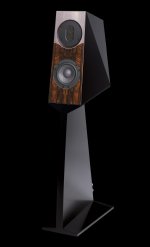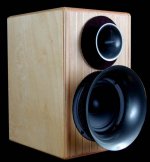-speaking of being on purpose.
The Kawero Chiara is specifically designed for this (and far more obviously physically):
"RAINER WEBER, KAISER ACOUSTICS
The Chiaras have some very innovative features that contribute significantly to their performance - two of which we can shed a bit more light on.The dip in the presence band is deliberate. We do not design to flat frequency response in that band, rather we design to the FletcherMunson curves of equal loudness perception. This dip only occurs on axis - by 30 degrees off, the response is very smooth (+/- 1dB in that range) and by changing toe-in of the speaker, you can actually ‘set’ the frequency response at the listening seat for individual preference."
The Kawero Chiara is specifically designed for this (and far more obviously physically):
"RAINER WEBER, KAISER ACOUSTICS
The Chiaras have some very innovative features that contribute significantly to their performance - two of which we can shed a bit more light on.The dip in the presence band is deliberate. We do not design to flat frequency response in that band, rather we design to the FletcherMunson curves of equal loudness perception. This dip only occurs on axis - by 30 degrees off, the response is very smooth (+/- 1dB in that range) and by changing toe-in of the speaker, you can actually ‘set’ the frequency response at the listening seat for individual preference."
Attachments
My guess is the tweeter is recessed by about 2 mm's. (..again, the behavior is somewhat exaggerated due to the 2 meter measurement). The Focus Audio Prestige FP90 BE Loudspeakers have nearly the same problem - actually with a bit of a deeper recess.
I still don't understand how a small recess is going to affect power compression like that in any way.
I still don't understand how a small recess is going to affect power compression like that in any way.
It's not really power compression at all because it's not "system-wide" - it doesn't lower spl at all axis's. Instead it "hits" just a narrow range of the polar output: specifically directly at the 0 degree axis. In the case of the Magico (and it's shallow depth "inset"), I wouldn't be at all surprised if the drop in pressure is within +/- 7.5 degrees (..and maybe more like +/-4 degrees). Something far more exaggerated like the Chira however probably expands that to over +/- 20 degrees.
Think of it as concentric combing.
It's that concentric nature that allows the diffraction to lower the response within a small area - it "builds" with an increase in pressure by the driver as it all "centers" together.
I believe that room modes do the same to bass freq.s, resulting in dynamically non-linear dips and peaks in pressure.
Last edited:
What about this....
Hi to all....
This one is one of the best new speaker in one of the online audio magazines (forgotten which).
should be VERY directional and no reflections from wall or else
And the tweeter is a AMT. I can find another picture that shows the AMT and how deep it is recessed!
Is this a wanted way of getting good sound - don`t know
Best
Olav
Hi to all....
This one is one of the best new speaker in one of the online audio magazines (forgotten which).
should be VERY directional and no reflections from wall or else
And the tweeter is a AMT. I can find another picture that shows the AMT and how deep it is recessed!
Is this a wanted way of getting good sound - don`t know
Best
Olav
Attachments
Last edited:
The tweeter is sourced from Scan Speak, as is the mid-range I believe (..though using Magico's diaphragm), as are the bass drivers. The drivers (not the tweeter) in their more expensive line are Morel - and actually are inferior. Only the mid-range is really "custom".
In the S series, the midrange motors are of the Coppersleeve Morel lineup, combined with Magico's 'nano-tube' cones.
There's no mistaking the midrange's frame in my eyes, as I have a set of Morel 6" CAW634, and the S3 I've seen in person. The S3 also had 22W/8857T style woofers with carbon fiber dustcaps- YUM!
I don't know why you are saying the Morel motor types would be inferior to the SS motors, but both have measured in their respective namesake models to have ultra low HD and be SOTA drive units.
Later,
Wolf
In the S series, the midrange motors are of the Coppersleeve Morel lineup, combined with Magico's 'nano-tube' cones.
There's no mistaking the midrange's frame in my eyes, as I have a set of Morel 6" CAW634, and the S3 I've seen in person. The S3 also had 22W/8857T style woofers with carbon fiber dustcaps- YUM!
I don't know why you are saying the Morel motor types would be inferior to the SS motors, but both have measured in their respective namesake models to have ultra low HD and be SOTA drive units.
Later,
Wolf
Ah, Morel for the mid.s - graci!
I've seen two problems with Morels before:
1 - the larger VC causing higher distortion (linear and non-linear) at the "top" of their bandwidth - which is largely moot for Magico, and
2 - an inability to maintain as flat a force curve over as extended a displacement as Scan Speak.
..sadly I can't remember where I've seen either before.
Ah, Morel for the mid.s - graci!
I've seen two problems with Morels before:
1 - the larger VC causing higher distortion (linear and non-linear) at the "top" of their bandwidth - which is largely moot for Magico, and
2 - an inability to maintain as flat a force curve over as extended a displacement as Scan Speak.
..sadly I can't remember where I've seen either before.Maybe I'm mistaken (as I was with the midrange's origin).

I can say that Jeff B measured the Coppersleeve titanium units (What Magico uses) for the Solstice, and is confident they are SOTA drivers. The HD is very low.
I can also say that the S3 midrange was excellent!!
Later,
Wolf
I'm going to take the risk and find out what the mini-8 can do. Since it is so small, I can always cut a bigger hole and swap to a nice dome.
They will be going into my pensil cabinets to mate with Alpair 10.2 full range drivers. Using a miniDSP, I'm going to try a variety of crossover slopes but the FR of the mini-8 will be shaped almost flat to 2khz and then more or less brick walled after that. That shaping will be on the tweeter channel only.
The Alpairs will be shaped independently as well for predictable crossover behavior.
I don't expect to get anywhere near a 2khz crossover, but that shaping should allow my 4.5khz crossover to work the way it is supposed to.
Hopefully this parametric equalization on each channel will help more than it hurts.
In all reality I know that I would probably be better off with a dome crossed lower without all this FR shaping but what the hell unconventional techniques are more fun.
Anyone interested in posts with calibrated mic measurements from REW before and after shaping for single drivers as well as combined response?
They will be going into my pensil cabinets to mate with Alpair 10.2 full range drivers. Using a miniDSP, I'm going to try a variety of crossover slopes but the FR of the mini-8 will be shaped almost flat to 2khz and then more or less brick walled after that. That shaping will be on the tweeter channel only.
The Alpairs will be shaped independently as well for predictable crossover behavior.
I don't expect to get anywhere near a 2khz crossover, but that shaping should allow my 4.5khz crossover to work the way it is supposed to.
Hopefully this parametric equalization on each channel will help more than it hurts.
In all reality I know that I would probably be better off with a dome crossed lower without all this FR shaping but what the hell unconventional techniques are more fun.
Anyone interested in posts with calibrated mic measurements from REW before and after shaping for single drivers as well as combined response?
Here are pictures of the purposed filters and crossover to be applied using the miniDSP.
As you can see, most of that shaping will be in a region where the crossover has drastically reduced the driver's response.
An externally hosted image should be here but it was not working when we last tested it.
An externally hosted image should be here but it was not working when we last tested it.
An externally hosted image should be here but it was not working when we last tested it.
An externally hosted image should be here but it was not working when we last tested it.
An externally hosted image should be here but it was not working when we last tested it.
As you can see, most of that shaping will be in a region where the crossover has drastically reduced the driver's response.
Last edited:
Any FR shaping that is not within the crossover region will be done with better Finite impulse response (FIR) filters that will be applied as a final layer. I may even be able to fix some of the phase/timing issues that are created by miniDSP's inferior Infinite impulse response (IIR) filters but the mini DSP has the advantage of applying filters on individual drivers and I have no way of using FIR filters like that with the equipment that I have.
- Status
- This old topic is closed. If you want to reopen this topic, contact a moderator using the "Report Post" button.
- Home
- Loudspeakers
- Multi-Way
- Best Cheap Dayton AMT Tweeter?

